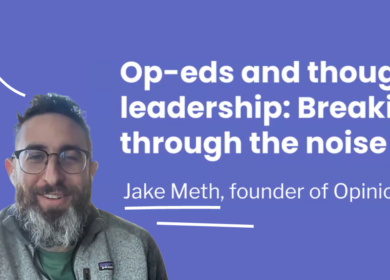
“I want to be in WIRED. How do I get into WIRED?”
By Chris Owen, Director, Hoffman Europe
As a PR pro, if I had £1,000 for every time a prospect or client said, “We’d like to get into WIRED / The Economist / the FT,” then I’d genuinely have no mortgage. I might even have some savings.
It’s not to say that PR agencies can’t get clients into top-tier publications — far from it — it’s just that it’s bloody hard and requires planning, digging for the right stories, and bringing all the elements together that will make the story fly.
It also involves us as PR professionals knowing the particular journalist we’re pitching it to — what’s their passion area and what are they focusing on right now? Our name standing out in their inbox because they know you as a good PR contact helps, (we discussed these very subjects in a podcast earlier this year with Bryan Glick, Editor-in-Chief at Computer Weekly)
Yet it’s all too often thrown in as a standardised expectation.
Advertorial versus editorial
I once had a client stand up in a meeting, bang on the table, and bellow, “For Christ’s sake — how difficult is it to get in The Times?” The answer to his question is, of course, that it’s relatively straightforward providing you dig into your wallet for some advertising.
But for earned editorial, it’s very much not straightforward.
The client was desperate to get some exposure in it (for himself, I’d add — he was expecting an interview with the publication), but had little to no regard to the editorial integrity involved. It’s our job as PR professionals, absolutely, to deliver coverage in top-tier publications, but “man with ego” isn’t a media story.
Then there was a prospect several years ago we chatted to ahead of a possible RFP. It was a utility switching service and — surprise, surprise — the CEO wanted to be profiled in WIRED. I asked the comms director if the CEO actually read WIRED and was told he “loves it” and would therefore love to be in it.
Great. Look, I love Liverpool Football Club. But that doesn’t mean I think I can buy some expensive football boots and, because I have the same number of legs as Mo Salah, that I’ll just walk straight into the first team.
The whole mentality creates a weird juxtaposition between desperately wanting to be in a magazine, but seemingly having little respect for the extremely high editorial bar to achieve it.
Crafting a story that resonates with top-tier publications
Securing coverage in top-tier publications is Definitely Not Easy — be it national newspapers, industry-leading trade magazines, technology and lifestyle “super-brands.” It takes understanding of how to craft a story, to whom, when, and with what. It takes them knowing you.
Overcoming this challenge is what makes PR and media relations so exciting — working hard alongside the client to develop (over a series of weeks and months if necessary), the right story with the right materials that will resonate and land that “frame-it-on-the-wall” piece.
It’s why I love my job as a PR pro (genuinely), 15 years into my career. But it was difficult to do when I started out, and it’s difficult now — arguably even more so given the reduction in media titles.
Most importantly however, addressing this expectation contradiction suits everyone involved in the media / PR / client relationship. Everyone wins once the understanding is there that landing coverage in top-tier publications is complicated and needs sophistication.
For one thing, journalists will have fewer half-baked pitches in their inboxes, (which most of the time languish there purely because there was little counsel agency-side with the client, and the pitch went anyway). Importantly, the PR agency and client work closer together on landing these pieces.

Understanding what kind of story it takes sets the proper client expectations
Where necessary the client can internally manage senior stakeholder expectations (with agency backing), about them thinking it’s as easy as walking up to Condé Nast and hoping to catch WIRED having a coffee and desperate to file copy about someone opening up a new office in WeWork, or staring at an opinion editorial plan waiting to fill it with whatever can land on their lap, (however good, bad, or just ugly). There’s nothing smart or strategic (or grounded in reality), in this approach.
Pragmatism and proper understanding are some of the best foundations to build from — it doesn’t negatively impact the potential for coverage in top-tier publications; if anything, it increases the likelihood of landing it, once the understanding of the effort needed to pull it off is recognised. As such, top-tier coverage becomes more collaborative and strategic, instead of masthead targeting without consideration for the copy on the pages behind it.

